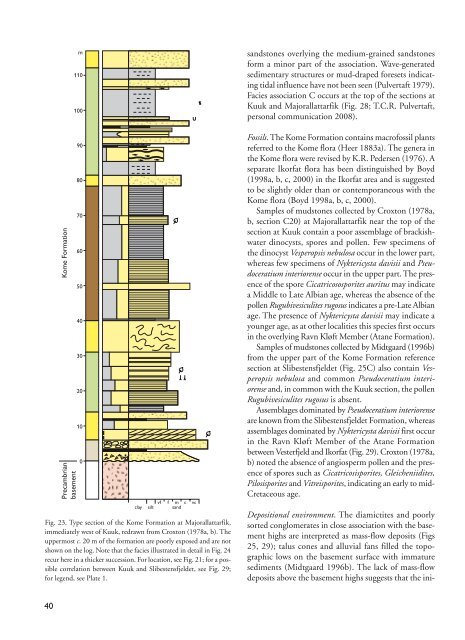Geological Survey of Denmark and Greenland Bulletin 19 ... - Geus
Geological Survey of Denmark and Greenland Bulletin 19 ... - Geus
Geological Survey of Denmark and Greenland Bulletin 19 ... - Geus
You also want an ePaper? Increase the reach of your titles
YUMPU automatically turns print PDFs into web optimized ePapers that Google loves.
Kome Formation<br />
Precambrian<br />
basement<br />
m<br />
110<br />
100<br />
90<br />
80<br />
70<br />
60<br />
50<br />
40<br />
30<br />
20<br />
10<br />
0<br />
clay<br />
silt<br />
vf f m c vc<br />
s<strong>and</strong><br />
Fig. 23. Type section <strong>of</strong> the Kome Formation at Majorallattarfik,<br />
immediately west <strong>of</strong> Kuuk, redrawn from Croxton (<strong>19</strong>78a, b). The<br />
uppermost c. 20 m <strong>of</strong> the formation are poorly exposed <strong>and</strong> are not<br />
shown on the log. Note that the facies illustrated in detail in Fig. 24<br />
recur here in a thicker succession. For location, see Fig. 21; for a possible<br />
correlation between Kuuk <strong>and</strong> Slibestensfjeldet, see Fig. 29;<br />
for legend, see Plate 1.<br />
s<strong>and</strong>stones overlying the medi um-grained s<strong>and</strong>stones<br />
form a minor part <strong>of</strong> the association. Wave-generated<br />
sedimentary structures or mud-draped foresets indicating<br />
tidal influence have not been seen (Pulvertaft <strong>19</strong>79).<br />
Facies association C occurs at the top <strong>of</strong> the sections at<br />
Kuuk <strong>and</strong> Majorallattarfik (Fig. 28; T.C.R. Pulvertaft,<br />
personal communication 2008).<br />
Fossils. The Kome Formation contains macr<strong>of</strong>ossil plants<br />
referred to the Kome flora (Heer 1883a). The genera in<br />
the Kome flora were revised by K.R. Pedersen (<strong>19</strong>76). A<br />
separate Ikorfat flora has been distinguished by Boyd<br />
(<strong>19</strong>98a, b, c, 2000) in the Ikorfat area <strong>and</strong> is suggested<br />
to be slightly older than or contemporaneous with the<br />
Kome flora (Boyd <strong>19</strong>98a, b, c, 2000).<br />
Samples <strong>of</strong> mudstones collected by Croxton (<strong>19</strong>78a,<br />
b, section C20) at Majorallattarfik near the top <strong>of</strong> the<br />
section at Kuuk contain a poor assemblage <strong>of</strong> brackishwater<br />
dinocysts, spores <strong>and</strong> pollen. Few specimens <strong>of</strong><br />
the dinocyst Vesperopsis nebulosa occur in the lower part,<br />
whereas few specimens <strong>of</strong> Nyktericysta davisii <strong>and</strong> Pseudoceratium<br />
interiorense occur in the upper part. The presence<br />
<strong>of</strong> the spore Cicatricososporites auritus may indicate<br />
a Middle to Late Albian age, whereas the absence <strong>of</strong> the<br />
pollen Rugubivesiculites rugosus indicates a pre-Late Albian<br />
age. The presence <strong>of</strong> Nyktericysta davisii may indicate a<br />
younger age, as at other localities this species first occurs<br />
in the overlying Ravn Kløft Member (Atane Formation).<br />
Samples <strong>of</strong> mudstones collected by Midtgaard (<strong>19</strong>96b)<br />
from the upper part <strong>of</strong> the Kome Formation reference<br />
section at Slibestensfjeldet (Fig. 25C) also contain Ves -<br />
peropsis nebulosa <strong>and</strong> common Pseudoceratium interiorense<br />
<strong>and</strong>, in common with the Kuuk section, the pollen<br />
Rugubivesiculites rugosus is absent.<br />
Assemblages dominated by Pseudoceratium interiorense<br />
are known from the Slibestensfjeldet Formation, whereas<br />
assemblages dominated by Nyktericysta davisii first occur<br />
in the Ravn Kløft Member <strong>of</strong> the Atane Formation<br />
between Vesterfjeld <strong>and</strong> Ikorfat (Fig. 29). Croxton (<strong>19</strong>78a,<br />
b) noted the absence <strong>of</strong> angiosperm pollen <strong>and</strong> the presence<br />
<strong>of</strong> spores such as Cicatricosisporites, Gleicheniidites,<br />
Pilosisporites <strong>and</strong> Vitreisporites, indicating an early to mid-<br />
Cretaceous age.<br />
Depositional environment. The diamictites <strong>and</strong> poorly<br />
sorted conglomerates in close association with the basement<br />
highs are interpreted as mass-flow deposits (Figs<br />
25, 29); talus cones <strong>and</strong> alluvial fans filled the topographic<br />
lows on the basement surface with immature<br />
sediments (Midtgaard <strong>19</strong>96b). The lack <strong>of</strong> mass-flow<br />
deposits above the basement highs suggests that the ini-<br />
40
















